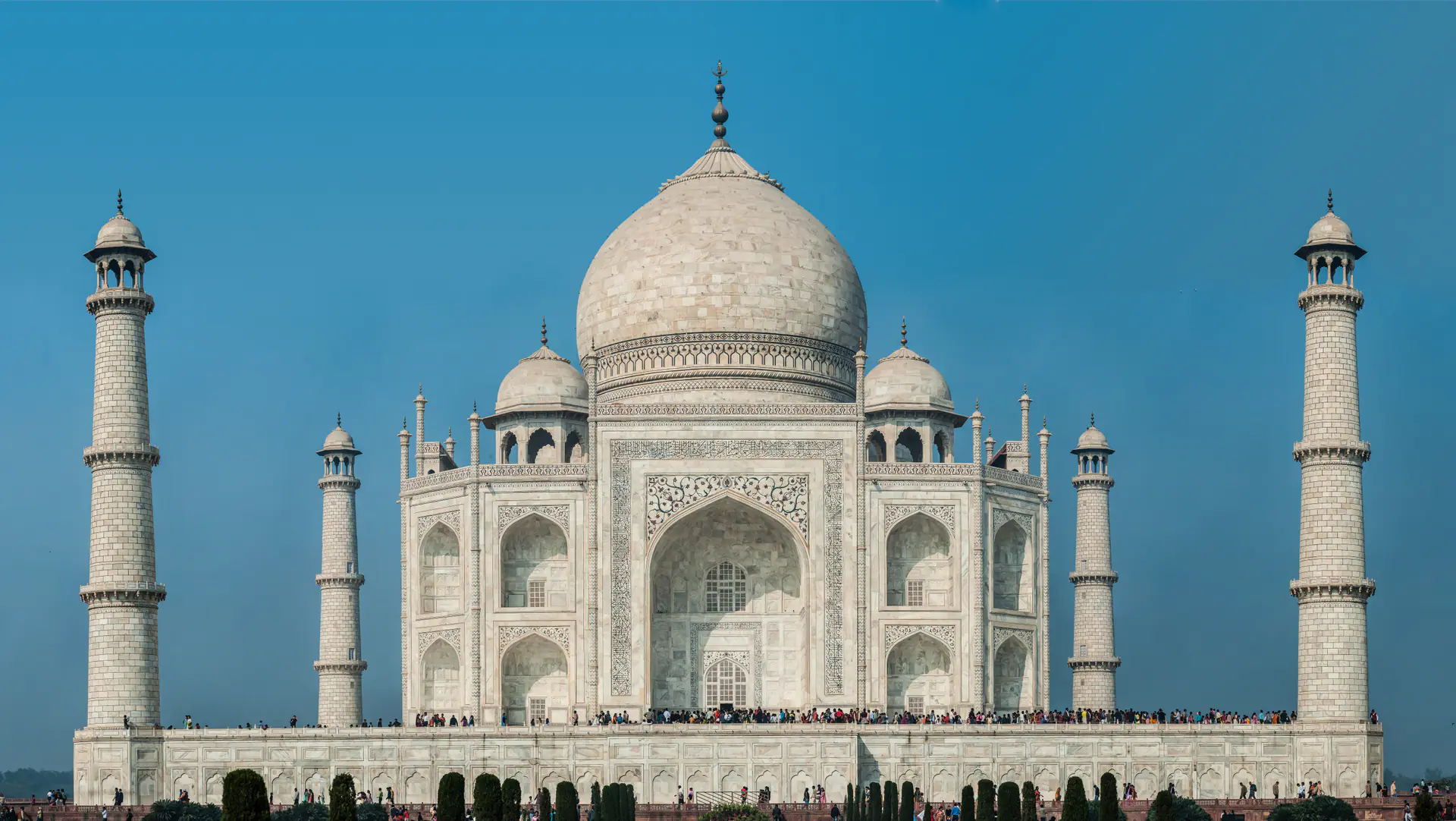
The Taj Mahal's Eternal Monument to Mughal Love
Emperor Shah Jahan's Ivory-White Marble Masterpiece
About This Site
The Taj Mahal stands as the most celebrated monument of Mughal India, an immense mausoleum of white marble built between 1632 and 1653 by Emperor Shah Jahan in memory of his beloved wife Mumtaz Mahal. This architectural masterpiece represents the zenith of Mughal art, harmoniously blending Persian, Islamic, Turkish, and Indian architectural styles into a perfect synthesis of form and meaning. The complex encompasses formal gardens, reflecting pools, and subsidiary buildings, all designed with meticulous symmetry and adorned with intricate inlay work featuring precious and semi-precious stones. The monument rises on a square marble platform with 95.5-metre sides, topped by a 23-metre marble dome sitting on a 12-metre cylindrical drum, with four minarets standing at the corners.
Why It Matters
This exceptional cultural monument demonstrates outstanding universal value as a masterpiece of human creative genius, representing the finest architectural and artistic achievement of Mughal civilisation whilst embodying the synthesis of Indo-Islamic art at its most refined expression. The monument symbolises eternal love through its perfectly symmetrical design and exquisite craftsmanship.
Architectural Marvels of the Taj Mahal
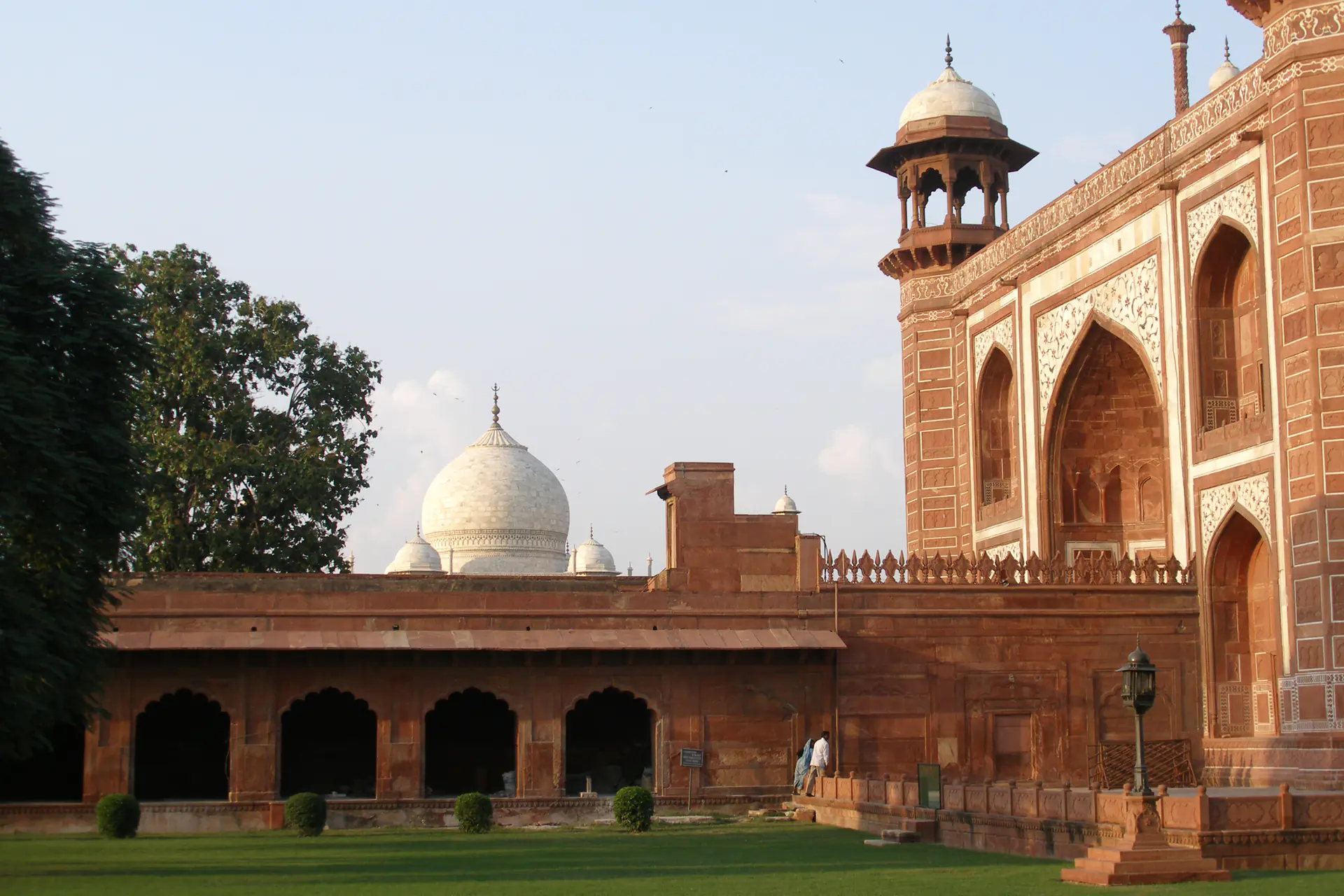
The Great Gate and First Glimpse
Enter through the magnificent Great Gate, a towering red sandstone structure adorned with white marble inlay work and calligraphic inscriptions from the Quran. As you pass through the central archway, the Taj Mahal reveals itself through the perfectly framed opening, creating one of architecture's most dramatic reveal moments. This deliberate design heightens anticipation whilst emphasising the monument's majesty. The gate's decoration mirrors elements found throughout the complex, featuring pietra dura inlay work and geometric patterns. The inscription over the archway invites the faithful to enter paradise, establishing the complex's spiritual symbolism from the entrance onwards.
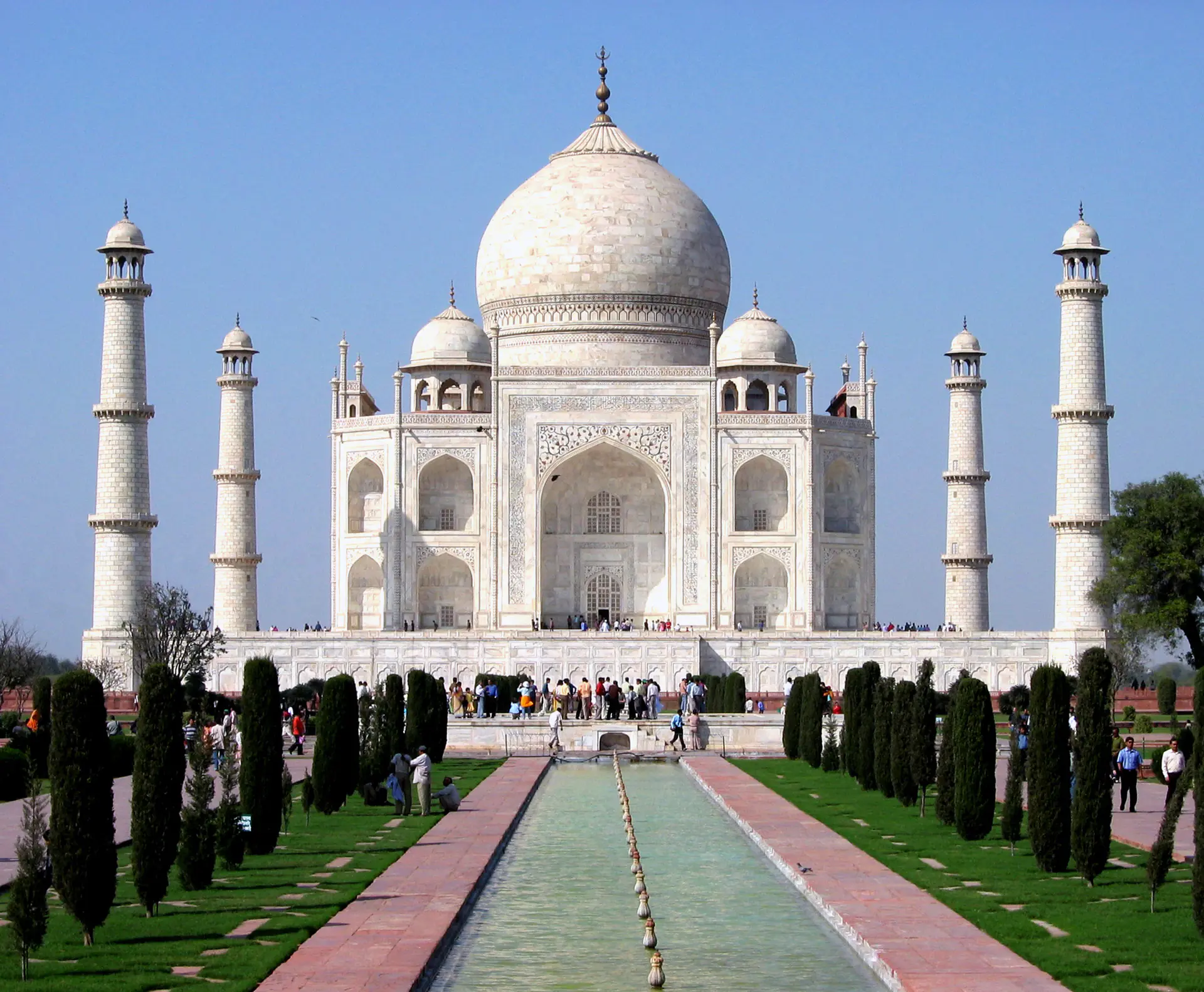
White Marble Splendour
The main mausoleum showcases extraordinary white marble that appears to change colours throughout the day—soft pinkish hue at dawn, dazzling white at midday, and warm golden tones at sunset. This optical phenomenon results from the translucent quality of Makrana marble from Rajasthan. The structure rises on a square platform measuring 95.5 metres per side, with the 23-metre-high marble dome sitting atop a 12-metre cylindrical drum. Four smaller chattri domes at the corners complement the main dome's elegant bulbous form. The exterior surfaces feature elaborate pietra dura inlay work depicting stylised flowers including tulips, irises, and daffodils composed from thousands of semi-precious stone pieces.
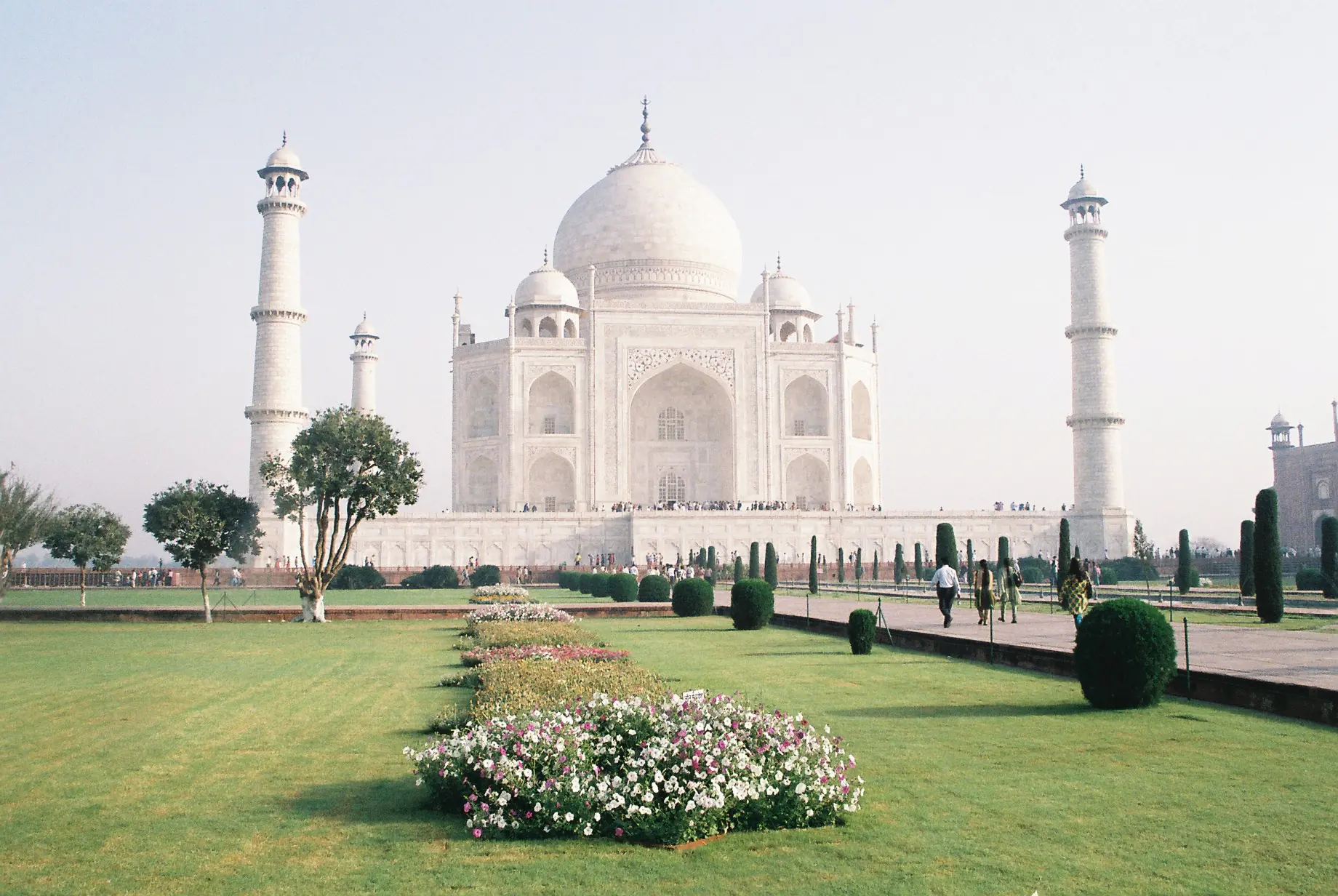
Charbagh Paradise Gardens
The formal Mughal gardens exemplify the charbagh layout, dividing the landscape into four quadrants separated by water channels representing the four rivers of Islamic paradise. The central marble lotus pool reflects the Taj Mahal's image, creating mirror-like compositions beloved by photographers. Raised pathways lined with cypress trees symbolise death and eternity, whilst the garden's geometric precision reflects divine order. Seasonal flowerbeds add colour whilst maintaining the structured layout. The garden design places the mausoleum at the northern end rather than the centre, an unusual departure from typical Mughal garden tombs. This arrangement maximises the dramatic southern approach whilst allowing the Yamuna River to flow behind the monument, providing spiritual significance. The garden's proportions carefully balance natural elements with architectural grandeur.
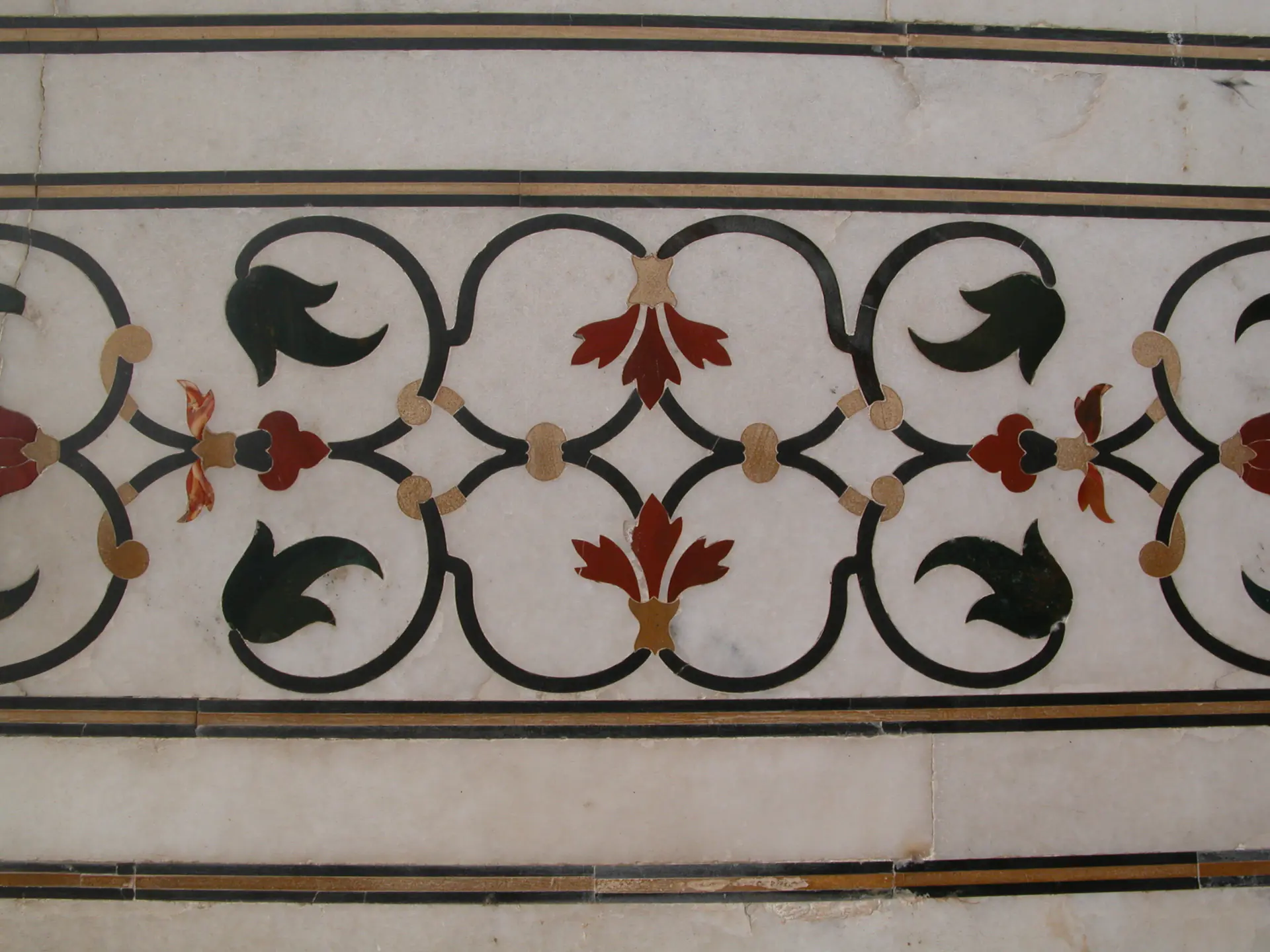
Interior Pietra Dura Artistry
Inside the main chamber, octagonal marble screens carved from single blocks feature intricate jali (lattice) work allowing filtered light to illuminate the cenotaphs of Mumtaz Mahal and Shah Jahan. The actual graves lie in a crypt below, following Islamic tradition. The interior walls showcase the finest pietra dura inlay work, with semi-precious stones including lapis lazuli from Afghanistan, jade from China, turquoise from Tibet, and carnelian from Arabia creating elaborate floral designs. Quranic verses in elegant calligraphy adorn the walls, their proportions carefully adjusted to appear uniform despite varying viewing distances. The chamber's acoustics create extraordinary reverberation, with sounds lasting over 20 seconds. The geometric ceiling design features pendant decorations whilst maintaining perfect symmetry throughout.
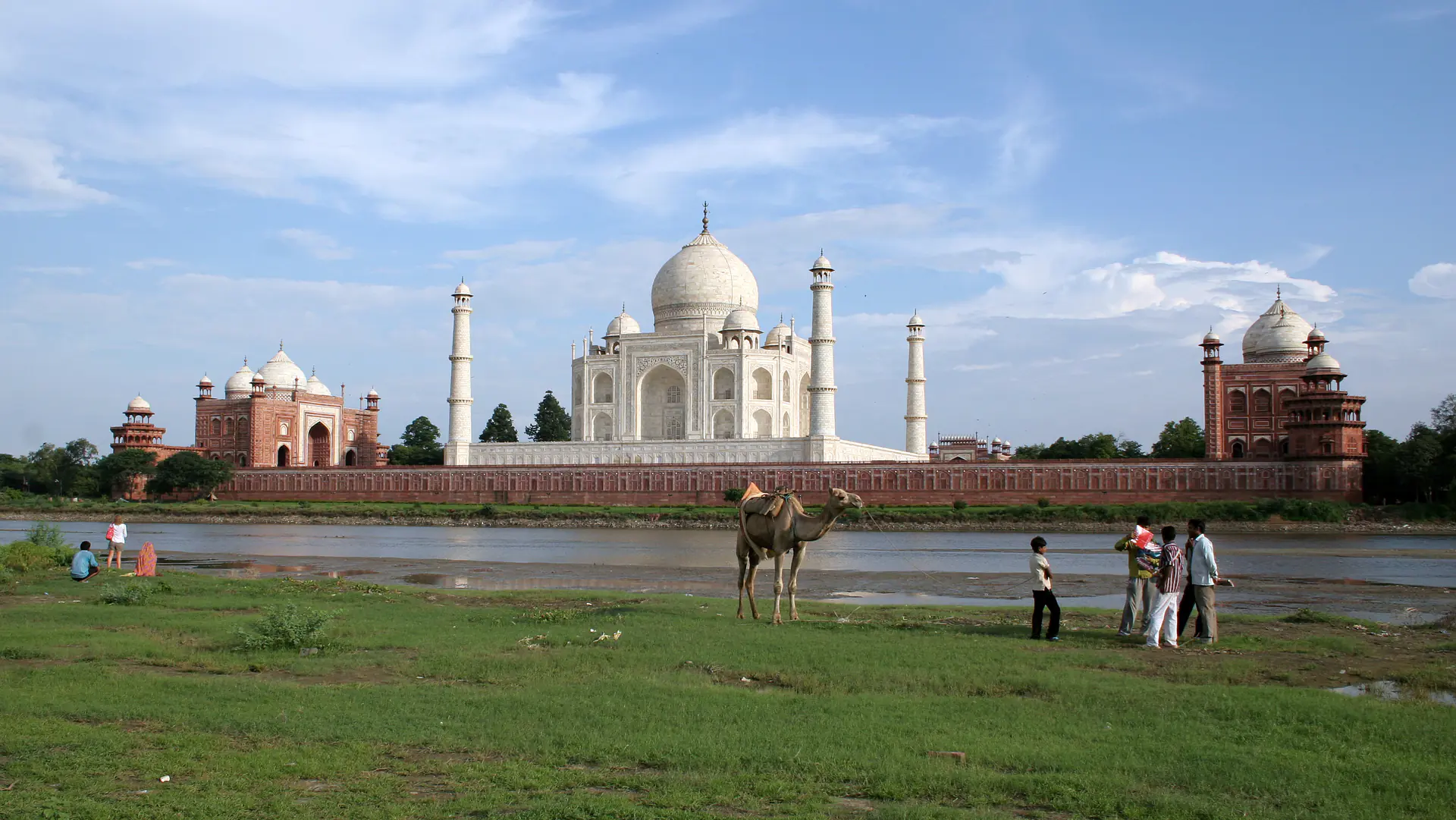
Yamuna River Perspective
View the Taj Mahal from across the Yamuna River for an alternative perspective showcasing the monument's relationship with its natural setting. This vantage point reveals the complete riverside elevation and demonstrates how the structure's white marble stands in dramatic contrast to the river landscape. Historically, the riverside provided ceremonial access for royal visitors arriving by boat. The black marble foundation contrasts with the white superstructure whilst protecting against river flooding. Some architectural historians suggest Shah Jahan intended to build a black marble mausoleum for himself across the river, creating a paired complex, though no conclusive evidence supports this romantic notion. The riverside view particularly impresses during sunset when the monument's marble captures golden light reflected from the water's surface.
Location & Planning
Located in Agra, 200 kilometres south of Delhi, accessible by train (2-3 hours) or car. Book tickets online to avoid queues. Monument closes Fridays. Entry restrictions prohibit large bags, food, and tripods. Hotels and restaurants available throughout Agra city.
Loading map...
Frequently Asked Questions
The Taj Mahal is an ivory-white marble mausoleum in Agra, India, built by Mughal Emperor Shah Jahan in memory of his wife Mumtaz Mahal. It represents the pinnacle of Mughal architecture through perfect symmetry, intricate pietra dura inlay work featuring semi-precious stones.
Emperor Shah Jahan commissioned the Taj Mahal in 1631 following his wife's death during childbirth. Chief architect Ustad Ahmad Lahori led over 20,000 artisans completing the main structure by 1643 and entire complex by 1653.
Shah Jahan built the Taj Mahal as an eternal tribute to his beloved wife Mumtaz Mahal, who died giving birth to their 14th child in 1631. The monument expresses his profound grief whilst creating an architectural representation of paradise on earth.
A comprehensive visit requires 2-3 hours minimum to explore the mausoleum interior, formal gardens, and subsidiary buildings whilst allowing time for photography and reflection. Many visitors spend half a day combining the Taj Mahal with nearby Agra Fort for complete Mughal heritage experience.
October through March offers pleasant weather avoiding monsoon and extreme summer heat. Sunrise visits (30-60 minutes before opening) provide optimal lighting conditions, dramatic marble colour changes from pink to white, cooler temperatures, and fewer crowds for photography.
Only small bags, cameras, water bottles, and essential items allowed through security. Large bags, food, tripods, and many electronics prohibited. Visitors must wear modest clothing covering shoulders and knees. Shoes removed before stepping onto marble platform using complimentary shoe covers.
The Taj Mahal appears to change colours throughout the day due to the translucent quality of Makrana white marble reacting to natural light—soft pinkish hue at dawn, brilliant white at midday, and warm golden tones at sunset. This optical phenomenon enhances the monument's ethereal quality.
UNESCO World Heritage Criteria
Inscribed in 1983, this site meets 1 of UNESCO's 10 criteria for Outstanding Universal Value
Criterion (i): Masterpiece of human creative genius
The Taj Mahal represents the pinnacle of human creative genius through its flawless symmetry, exquisite pietra dura inlay work featuring precious stones, and harmonious synthesis of Persian, Islamic, Turkish, and Indian architectural traditions. Its perfect proportions, innovative double-dome construction, and refined decorative programme demonstrate unprecedented artistic achievement in Mughal architecture.
Historical Context
Commission and Construction (1632-1653)
Emperor Shah Jahan commissioned the Taj Mahal following the death of his beloved wife Mumtaz Mahal during childbirth in 1631, with construction beginning in 1632. Chief architect Ustad Ahmad Lahori led a workforce exceeding 20,000 artisans and craftsmen, with materials transported from across Asia and India.
Mughal Zenith (17th century)
The completed Taj Mahal represented the pinnacle of Mughal architectural achievement, synthesising Persian, Islamic, and Indian design traditions. Shah Jahan was later imprisoned by his son Aurangzeb in nearby Agra Fort, spending his final years gazing at his creation.
Decline and Neglect (18th-19th centuries)
Following the Mughal Empire's decline, the Taj Mahal suffered neglect and vandalism. British colonial forces desecrated the monument, removing precious stones and lapis lazuli inlay work from the decorative panels. The formal gardens deteriorated significantly as systematic maintenance ceased and the water features fell into disrepair.
British Restoration (late 19th century)
Lord Curzon, British Viceroy of India, initiated comprehensive restoration programmes in 1908 to reverse decades of neglect. The gardens were completely redesigned following authentic Mughal principles whilst structural repairs addressed deterioration throughout the complex. British documentation brought international attention to the monument's significance.
UNESCO Recognition and Conservation (1983-present)
UNESCO designated the Taj Mahal a UNESCO World Heritage Site in 1983, acknowledging its outstanding universal value. Modern conservation efforts combat environmental pollution, particularly acid rain from nearby industries threatening the marble's integrity. Ongoing restoration programmes ensure this masterpiece's preservation for future generations.
Conservation & Protection
Current Conservation Status
The Archaeological Survey of India oversees comprehensive conservation programmes protecting the Taj Mahal through scientific monitoring, pollution control measures, and structural stabilisation whilst managing sustainable tourism for millions of annual visitors.
Conservation Challenges
- Air pollution from nearby industries and vehicular emissions causing yellowing and corrosion of white marble surfaces through acid rain deposition
- Yamuna River pollution and declining water levels threatening the monument's foundation stability and historical relationship with the waterfront
- Tourism pressure exceeding sustainable capacity requiring sophisticated visitor flow management and protective infrastructure
- Insect infestation, particularly Goeldichironomus mosquitoes leaving green-black excrement stains on marble surfaces requiring regular cleaning
Active Conservation Efforts
- Supreme Court-mandated Taj Trapezium Zone restricting industrial emissions and vehicular traffic within 10,400 square kilometres surrounding the monument
- Advanced mud pack treatment using fuller's earth to remove yellowing and restore marble's original white lustre without damaging stone integrity
- Digital monitoring systems tracking structural stability, air quality, and visitor impact through comprehensive sensor networks
- Educational programmes promoting heritage conservation awareness whilst supporting local community benefits from sustainable cultural tourism
Image & Content Attribution
Research & Content Sources
Photography & Visual Media
Last updated: 11 October 2025